We have already studied the different biological macromolecules, which comprise the main components of cell structure. So, we are now in position to deal with a new topic within this section: cell biology.
In the same way that bricks are the basic building blocks of a wall, cells are the building blocks of living organisms.
There is a huge range of cells, each one specialised in a particular function: growth, development and daily maintenance of the organism, but all of them share some fundamental features.
Among the diverse types of cells we find, for example, immune system cells that protect us against bacterial infections, blood cells that carry oxygen and nutrients throughout our body or epithelial cells that protect the body surface and cover organs and body cavities.
Among the diverse types of cells we find, for example, immune system cells that protect us against bacterial infections, blood cells that carry oxygen and nutrients throughout our body or epithelial cells that protect the body surface and cover organs and body cavities.
Cells are considered the smallest unit of a living being. When several cells of the same class interconnect with each other sharing a common function they become a tissue. Several tissues form an organ and several organs make up a system (nervous, circulatory, digestive systems…). Lastly, the union of several systems working together and in concert comprises an organism like the human being.
Cells are classified into two major groups: prokaryots and eukaryots. But all of them have four basic components: the cell membrane that protects it from outside, the cytoplasm that is composed of the cytosol with a jelly consistency and floating on it other cell components, the DNA that contains the genetic information of the cell and the ribosomes that synthesise proteins..
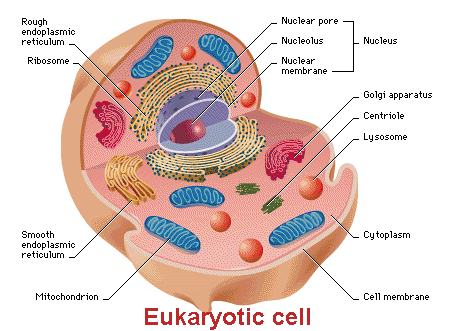
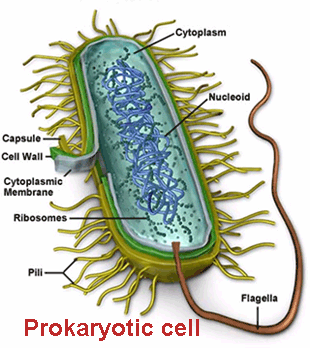
In prokaryotic cells, the organism (most of the time unicellular) lacks a nucleus with what its DNA located in the cell centre, or ‘nucleoid’. Bacteria and archaea[1] belong to this category.
On the contrary, protist[2], fungi, plants and animals cells are eukaryotic cells, which differ from the prokaryotic cells by having a nucleus that encloses its genetic material (DNA) surrounded by a membrane, a large variety of organelles[3] limited by membranes and several rod-shaped chromosomes.
Due to the purpose of this blog, I will only focus on the components and functions of eukaryotic cells and particularly on animal cells.
The plasma membrane
We start the study of the diverse cell components with the plasma membrane or cell membrane, which separates the interior content of the cell from the external environment.
It consists of a lipid bilayer with many embedded proteins in it, which controls the movement of water, ions, oxygen, organic molecules and waste disposal (carbon dioxide and ammonia) between the inside and outside of a cell.
Microvilli located on the wall of the small intestine are an example of plasma membranes specialised in the absorption task. They are in charge of absorbing the nutrients from the digested food.
In the case of celiacs, the consumption of gluten (a cereal protein) causes an autoimmune respond that attacks these cells causing malnutrition, abdominal pain and diarrhoea.
In the case of celiacs, the consumption of gluten (a cereal protein) causes an autoimmune respond that attacks these cells causing malnutrition, abdominal pain and diarrhoea.
The cytoplasm
The cytoplasm is the region between the plasma membrane and the nuclear membrane.
It has a jelly-like and semisolid consistency called cytosol, on which the organelles are suspended.
It has a jelly-like and semisolid consistency called cytosol, on which the organelles are suspended.
Also the cytoskeleton and a number of biochemical substances, such as amino acids, nucleic and fatty acids, polysaccharides, simple sugars and sodium, potassium and calcium ions form part of the cytoplasm.
In the cytoplasm a large range of metabolic reactions, like the synthesis of proteins, take place.
In the cytoplasm a large range of metabolic reactions, like the synthesis of proteins, take place.
The nucleus
The nucleus is the most significant organelle in the cell. It contains the DNA and leads the synthesis of proteins and ribosomes.The nuclear envelope
The nuclear envelope is a double-membrane structure, in which both the inner and the outer membranes are formed by phospholipid bilayers (to revisit what a phospholipid bilayer see the post: “Lipids”).
This structure has a set of pores on its surface to facilitate the movement of ions, molecules and RNA between the nucleoplasm and the cytoplasm.
The nucleoplasm is a semisolid fluid ubicated inside the nuclear membrane where the chromatin and the nucleolus are.
This structure has a set of pores on its surface to facilitate the movement of ions, molecules and RNA between the nucleoplasm and the cytoplasm.
The nucleoplasm is a semisolid fluid ubicated inside the nuclear membrane where the chromatin and the nucleolus are.
Chromosomes and chromatin
In eukaryotic cells, chromosomes are structures inside the nucleus made up of DNA and therefore, the hereditary genetic material.
Each eukaryotic species has a particular number of chromosomes in its cell nuclei, which in the case of human beings is 46 (23 pairs).
Chromosomes are only distinguishable when the cell is about to initiate the cell division process. When the cell is in the other phases of the cell cycle, the chromosomes join certain proteins (histones) forming a complex known as chromatin, which looks like a tangled skein.
Chromatin characterises the substance that forms the chromosomes both in decondensed and condensed states.
Each eukaryotic species has a particular number of chromosomes in its cell nuclei, which in the case of human beings is 46 (23 pairs).
Chromatin characterises the substance that forms the chromosomes both in decondensed and condensed states.
The nucleolus
The nucleolus is the part of the nucleus that aggregates the ribosomal RNA (rRNA) with specific proteins to assemble the ribosomal subunits. These subunits are then transported to the cytoplasm where they are put together. This is the way in which the nucleus performs one of its principal functions, the synthesis of ribosomes.
Ribosomes
Ribosomes are the organelles responsible for protein synthesis. They are made up of two subunits: large and small subunits.
They can be found in groups, or individually next to the cytoplasmic side of the plasma membrane, the endoplasmic reticulum or stuck to the outer membrane of the nuclear membrane.
They can be found in groups, or individually next to the cytoplasmic side of the plasma membrane, the endoplasmic reticulum or stuck to the outer membrane of the nuclear membrane.
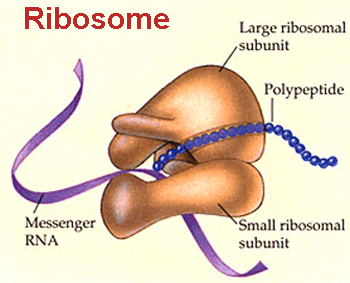
Ribosomes receive instructions from the nucleus to produce proteins by means of DNA, this DNA is transcripted to mRNA and this one gets to the ribosome. Once there, the code provided by the nitrogenous bases of the mRNA is translated in a set of amino acids with a specific order, giving rise to the required protein.
Ribosomes are abundant in those cells that synthesise large amounts of protein, like pancreatic cells, which produce multiple digestive enzymes.
Mitochondria
Mitochondria are usually known as the energetic centre of cells, they take charge the production of 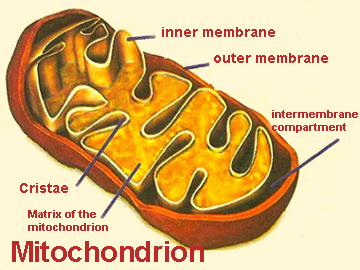 the most crucial energetic molecule for cells: ATP (adenosine triphosphate). This molecule is generated using glucose and other nutrients during cellular respiration. During this process, mitochondria use oxygen and produce carbon dioxide as waste, which is expelled from the organism when we exhale.
the most crucial energetic molecule for cells: ATP (adenosine triphosphate). This molecule is generated using glucose and other nutrients during cellular respiration. During this process, mitochondria use oxygen and produce carbon dioxide as waste, which is expelled from the organism when we exhale.
 the most crucial energetic molecule for cells: ATP (adenosine triphosphate). This molecule is generated using glucose and other nutrients during cellular respiration. During this process, mitochondria use oxygen and produce carbon dioxide as waste, which is expelled from the organism when we exhale.
the most crucial energetic molecule for cells: ATP (adenosine triphosphate). This molecule is generated using glucose and other nutrients during cellular respiration. During this process, mitochondria use oxygen and produce carbon dioxide as waste, which is expelled from the organism when we exhale.Mitochondria are oval-shaped with a double membrane (phospholipid bilayer with embedded proteins) and have their own ribosomes and DNA.
Their inner layer has a set of folds called mitochondrial cristae, surrounded by the mitochondrial matrix. Both develop different roles in the cellular respiration.
Their inner layer has a set of folds called mitochondrial cristae, surrounded by the mitochondrial matrix. Both develop different roles in the cellular respiration.
Peroxisomes
Peroxisomes are small, spherical organelles surrounded by a monolayer membrane.
They carry out oxidation reactions that break down amino acids and fatty acids, as well detoxifying poisons that enter our body.
For instance, the peroxisomes of hepatic cells must detoxify the alcohol we consume.
They carry out oxidation reactions that break down amino acids and fatty acids, as well detoxifying poisons that enter our body.
For instance, the peroxisomes of hepatic cells must detoxify the alcohol we consume.
Vesicles and vacuoles
These organelles are sac-shaped and their functions are transport and storage. The main difference between them is their size (vacuoles are larger) and the fact that vesicle membranes can fuse with the plasma membrane or with membranes of other components inside the cell.
The centrosome
The centrosome is a microtubule-organising centre (MTOC) located near animal cell nuclei. Centrosomes are made up of two structures that are perpendicular to each other named centrioles. These centrioles are cylinders of nine triplets of microtubules each.
The centrosome replicates before starting cell division and the centrioles pull the duplicated chromosomes to the opposite poles of the cell during its division stage.
Lysosomes
Lysosomes are dumps of cells. Their pH is more acidic than cytoplasm´s, which favours the fact that their enzymes are more active and assist the degradation of nucleic acids, lipids, polysaccharides and even the recycling of organelles that are no longer necessary for the cell by enclosing and digesting them.
[1] Unicellular microorganisms similar to bacteria.
[2] Unicellular organisms that form colonies at times.
[3] Small organs specialised in cell functions, in a similar way to our body organs.
[2] Unicellular organisms that form colonies at times.
[3] Small organs specialised in cell functions, in a similar way to our body organs.
Sources: OpenStax College, Biology. OpenStax College. 30 May 2013.
http://michelleburden.weebly.com/cell-types-prokaryotes-v-eukaryotes-plant-v-animal.html
http://cosbiology.pbworks.com/w/page/11556247/Lesson%204-02%20Prokaryotes%20and%20Eukaryotes
http://ernsstev.com/bilayer-pattern-in-cell-membrane/
http://www.biologyexams4u.com/2012/11/difference-between-chromatin-and.html#.Vu1BANI7uSp
http://jptregularbio.pbworks.com/w/page/79985510/Cells
https://oggisioggino.wordpress.com/2013/11/01/las-celulas-procariotas-y-eucariotas/
http://www.studyrankers.com/2015/06/cell-the-unit-of-life-class-11th-ncert-solutions.html
http://michelleburden.weebly.com/cell-types-prokaryotes-v-eukaryotes-plant-v-animal.html
http://cosbiology.pbworks.com/w/page/11556247/Lesson%204-02%20Prokaryotes%20and%20Eukaryotes
http://ernsstev.com/bilayer-pattern-in-cell-membrane/
http://www.biologyexams4u.com/2012/11/difference-between-chromatin-and.html#.Vu1BANI7uSp
http://jptregularbio.pbworks.com/w/page/79985510/Cells
https://oggisioggino.wordpress.com/2013/11/01/las-celulas-procariotas-y-eucariotas/
http://www.studyrankers.com/2015/06/cell-the-unit-of-life-class-11th-ncert-solutions.html


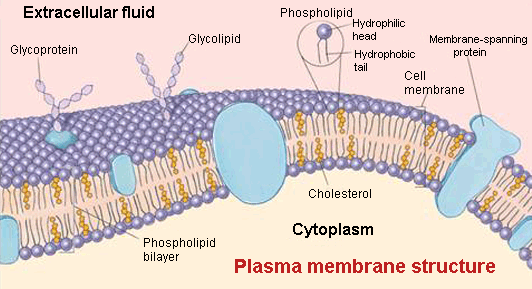





Your opinion matters